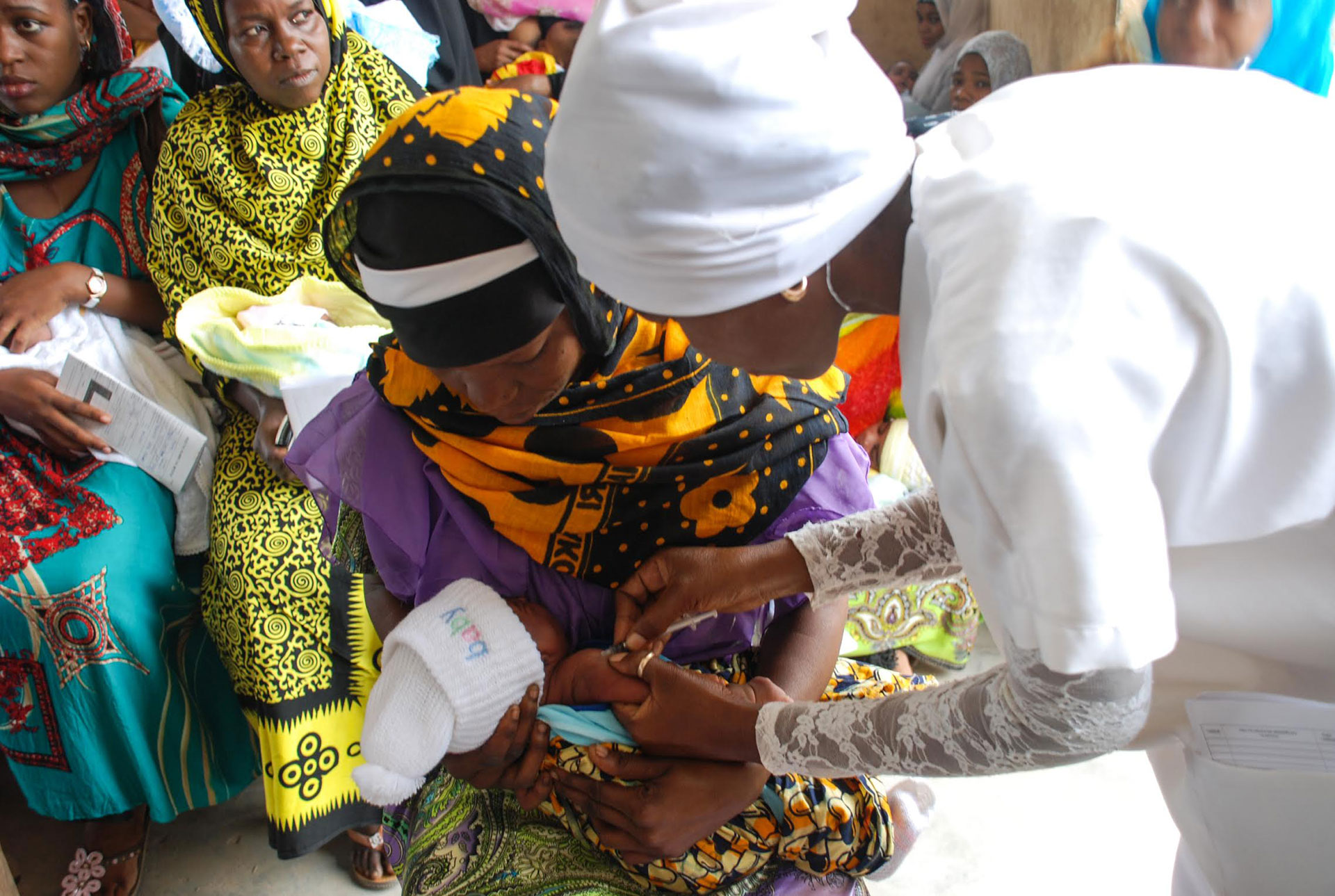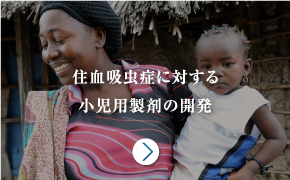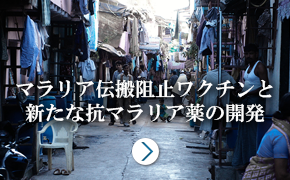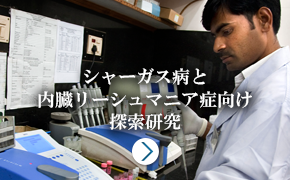Investment
Case Studies
Development of a Transmission-Blocking Vaccine & Novel Drug Discovery for Malaria
In order to bring the impact of the GHIT Fund’s work to life, we have
initiated the creation of case studies that convey the potential impact of our invested
innovation on economies and societies in endemic countries.
These case studies serve as a bridge between our mission, vision, and product development process by bringing into focus the ultimate goals of the GHIT Fund and all its partners: enabling those in the developing world to break free from the shackles of disease and poverty and pursue the level of prosperity and longevity now common in the industrialized world.
These case studies serve as a bridge between our mission, vision, and product development process by bringing into focus the ultimate goals of the GHIT Fund and all its partners: enabling those in the developing world to break free from the shackles of disease and poverty and pursue the level of prosperity and longevity now common in the industrialized world.
Disease Impact Overview
The Lal family recently migrated to Mumbai, India, and was soon to face a nearly invisible danger in the crowded and impoverished area known as the Dharavi slum. Raj Lal moved to Mumbai in search of work after losing his farming job in Kashmir. Along with his pregnant wife Priya and their four-year-old daughter Dia, Raj moved to a community that is home to some of the poorest residents in Mumbai. Most homes in Dharavi lack running water, toilets, electricity, and there is no effective waste management program in place. Dharavi is densely populated with roughly 750,000 to 1,000,000 people living within the 500-acre slum, creating an environment susceptible to quick transmission of infectious diseases1,2.
The heavy monsoon rains drain into pools of stagnant water, which serve as breeding grounds for mosquitoes that spread malaria. Raj was unknowingly bitten by an infected mosquito while queuing at night for a communal toilet. Weeks later, he was rushed to a clinic after slipping into a coma. His prior symptoms included high fever, shaking chills, vomiting, and diarrhea. Raj was fortunate to receive anti-malarial drugs in time to prevent permanent damage; if left untreated, the infection could have led to kidney failure, seizure, severe anemia, and even death3. Although Raj recovered, his encounter with malaria resulted in weeks of lost wages for both him and his wife, as she cared for him.
Malaria affects populations in at least 97 tropical and sub-tropical countries, across widespread geographies that include Sub-Saharan Africa, South Asia, and parts of Central America, South America, the Caribbean, Southeast Asia, and the Middle East. 584,000 people died from the disease worldwide in 2013. In the same year, about 198 million malaria cases occurred worldwide and approximately 3.2 billion people (almost 50% of the world’s population) were at risk of being infected4. The risk of infection is partially attributable to a large percentage of the endemic population that harbors malaria parasites without showing symptoms of the disease. In these cases, patients are unaware of the infection and do not receive treatment, which further aids the transmission of the disease. In fact, the occurrence of asymptomatic malaria is estimated to be higher than that of symptomatic malaria4,5.
Unfortunately, the Lal family is not yet out of danger. Dia’s young age and Priya’s pregnancy place them at higher risk of being infected and having complications from malaria. Children under age 5 years have weaker immune systems, are more vulnerable to the most severe forms of the disease, and are at higher risk of death if infected4. In children, malaria causes severe anemia, respiratory distress, or cerebral distress that can lead to brain damage and even coma4,6. Sadly, 78% of worldwide malaria deaths (nearly a half million) in 2013 were among children under the age of 5 years – that’s over 1,200 child deaths per day as a result of being bitten by an infected mosquito4. If infected, Priya is at increased risk of miscarriage, maternal death, severe anemia, and transmitting the disease to her unborn child4. A low birth weight for an infected baby is a leading factor for infant mortality and impaired development6.
Moreover, anyone in the Lal family can become re-infected by malaria multiple times. Having contracted malaria previously does not necessarily prevent future reinfection by the same or different malaria parasite strain. Additionally, the disease can re-emerge if the parasite is not completely eliminated from the body after infection. In many cases, the parasite remains dormant within the body and reactivates at a later point, causing symptoms againm4,5.
The economic and social impacts of malaria are as alarming as the disease. Malaria diminishes worker productivity and increases healthcare costs, which can lower a nation’s gross domestic product by as much as 6%7. Businesses in endemic regions also suffer when the disease becomes a deterrent of tourism and investment. In Africa alone, malaria costs $12 billion a year in lost productivity and can cut household income by 25%8. A recent study estimates that $208.6 billion in economic gains could be realized between 2013 and 2035 if malaria were reduced and eliminated from the world9.
Social impacts are most notable in education: malaria keeps more children out of school than any other disease10. In Africa alone, malaria results in 10 million missed days each year; each Kenyan primary school student misses an estimated 20 schooldays per year due to malaria. Lost school days translate into higher failure rates, repeated school years, and more drop-outs10,11.
Combined, the health, economic, and social impacts of malaria worldwide are a staggering call for effective and affordable interventions to eliminate the disease.
Current Malaria Interventions
Current efforts against malaria focus on preventing mosquito bites, administering drugs to those with symptoms, and administering preventative drugs for high-risk populations4. There are no vaccines available today for preventing malaria infection.
| Current Malaria Interventions4, 9, 13 | |
|---|---|
| Intervention | Limitations |
| Insecticide- treated Mosquito Bed Nets |
|
| Indoor Insecticide Applications |
|
| Anti-malarial Drugs |
|
| Anti-malarial Chemo- protective Drugs |
|
Luckily for Raj and the nearly 70% of patients who are properly diagnosed and treated, malaria is treatable with anti-malarial drugs that eliminate the parasite from the body4. Health care providers generally conduct a variety of analyses before administering specific drug treatments, which include diagnostic tests to identify the specific infectious parasite, the drug-resistant status of the parasite in the geographic area of infection, the stage of the disease, and pregnancy status of female patients12. One of the most effective anti-malarial treatments available today is a series of drugs known as artemesinin-based combination therapies (ACTs), which are primarily used for malaria infections caused by the P. falciparum parasite4. Drugs used for infections caused by other malaria parasites or complicated cases with P. falciparum include chloroquine, primaquine, artesunate, mefloquine and quinidine12.
In addition to those for treating patients after infection, certain drugs can prevent malaria infection altogether. Known as anti-malarial chemoprotectives, they are typically given to pregnant females, infants, and children like Priya and Dia, who are at a higher risk of developing complications from the disease and live in areas of high transmission4. Travelers to endemic areas are also advised to take anti-malarial chemoprotective drugs as a precaution.
Unfortunately, the effectiveness of current malaria interventions is compromised by their reliance on human behavior and daily compliance. Anti-malarial drugs and chemoprotectives, for example, require multiple doses over several days and months, which lead to low patient compliance, incomplete cure, and facilitate the development of drug-resistant parasite strains13. Recently, drug-resistant strains of the parasite have emerged in Cambodia, Laos, Myanmar, Thailand and Vietnam – which further complicates treatment options and elimination efforts4. Additionally, some partner drugs used with ACTs have shown decreased effectiveness13.
Although current interventions have made great strides toward managing malaria, their limitations call for better options. Committed to eliminating the devastating global health and economic impacts of malaria, the GHIT Fund has forged innovative partnerships for creating effective and robust malaria interventions. Two partnerships that are part of the GHIT Fund’s multifaceted approach for eliminating malaria include: (1) a drug discovery partnership between Daiichi Sankyo Company, Limited and Medicines for Malaria Venture and (2) a vaccine development partnership between Ehime University and the PATH Malaria Vaccine Initiative.
Anti-malarial Drug Discovery Partnership
-
The anti-malarial drug discovery partnership is funded under the GHIT Fund’s “Hit-to-Lead
Platform,” which focuses on the aspect of the drug discovery and development process that
progresses “hits” into “leads” that can then be optimized into drug candidates. The
partnership is comprised of Daiichi Sankyo, a leading global pharmaceutical company based in
Japan, and Medicines for Malaria Venture (MMV), a product development nonprofit based in
Switzerland. This unique partnership provides MMV with access to Daiichi Sankyo’s drug
discovery portfolio and scientific expertise for the purpose of finding new anti-malarial
drugs.
The partnership has already screened 50,000 drug compounds from Daiichi Sankyo’s “library” of chemical compounds and has identified several promising hits for further testing. The partnership aims to identify at least one lead anti-malarial drug candidate for further development from these hits, with the following attributes that overcome the limitations of current malaria interventions:
-
“Hits” and “Leads”
One proven drug discovery process involves screening chemical compounds using a combination of computer modeling and laboratory tests to find those most promising for a disease. The process is conducted in a step-wise manner; initially, compounds are screened to find a series of potential drug candidates called “hits.” Hits are then further evaluated to find the most promising “leads” suitable for human testing, of which the most safe and effective are eligible to become drugs. Often during this process, thousands of compounds are screened, of which dozens become hits, few become leads, and one becomes a drug.
- Improved Treatment - The desired drug candidate will provide effective treatment against all five malaria parasite species that infect humans, need only a single dose, and have low susceptibility to parasite resistance. Additionally, the desired candidate will be:
- Fast acting: providing rapid, initial parasite clearance from the bloodstream to deliver quick relief from symptoms
- Long lasting: providing longer-term effectiveness by remaining in the body and clearing residual parasites for up to 4 weeks
- Relapse preventing and transmission blocking: providing clearance of malaria parasites in dormant stages of parasitic activity (i.e., when patients are asymptomatic), which would prevent malaria relapse as well as transmission of the disease
- Improved Chemoprotection - The desired drug candidate will prevent malaria infection and require a lower dose regimen (e.g., one dose per outbreak, or one dose per month) than current anti-malarial chemoprotectives
- Cost – An affordable anti-malarial drug will be essential for reducing the health and economic impacts of malaria, as endemic areas are often the most impoverished
- Drug form and route of administration – To best ensure patient adherence and to simplify delivery, the drug would ideally be a tablet and administered orally
- Packaging – If the drug needs to be administered with other drugs in order to be effective, it should ideally be combined with other drugs into a single tablet, or less desirably, presented in a combined package. Furthermore, the package should protect against counterfeiting and allow for patients to confirm its authenticity.
- Testing – Thorough clinical testing must be performed to ensure that new anti-malarial drugs are safer and more effective than currently available interventions
Transmission-Blocking Vaccine Partnership
 Photo Credit: PATH MVI
Vaccines that prevent malaria infection or its transmission offer the most promise for eliminating
malaria globally, as they offer increased effectiveness and relatedly simple administrations that do not
depend on user behavior. Two vaccine doses, for example, are often all that is required to provide a
lifetime of protection. To this end, the GHIT Fund is supporting a partnership between Ehime University
in Japan and the PATH Malaria Vaccine Initiative (PATH MVI) in the USA to create a
“transmission-blocking” vaccine that aims to prevent the spread of parasites responsible for
malaria.
Photo Credit: PATH MVI
Vaccines that prevent malaria infection or its transmission offer the most promise for eliminating
malaria globally, as they offer increased effectiveness and relatedly simple administrations that do not
depend on user behavior. Two vaccine doses, for example, are often all that is required to provide a
lifetime of protection. To this end, the GHIT Fund is supporting a partnership between Ehime University
in Japan and the PATH Malaria Vaccine Initiative (PATH MVI) in the USA to create a
“transmission-blocking” vaccine that aims to prevent the spread of parasites responsible for
malaria.PATH MVI and Ehime have been collaborating towards the development of a transmission blocking malaria vaccine since 2013. Both partners bring unique expertise in vaccine development; Ehime offers a proprietary manufacturing platform to produce components of the vaccine, while PATH MVI identifies and accelerates malaria vaccine candidates through the development process.
The vaccine specifically aims to block the transmission of Plasmodium falciparum, one of the deadliest and most prevalent forms of the parasites causing malaria. If proven to be safe and effective in humans, it will be combined with current interventions and other vaccines to reduce the global impact of malaria.
-
A transmission-blocking vaccine is a particularly attractive solution for regional control
of malaria in densely populated areas such as Dharavi. Mosquitoes breed in localized areas
and each mosquito with the malaria parasite can infect up to hundreds of humans. Raj, for
example, is likely to transmit the parasite to as many as 30 people in his family and
neighborhood14. If 70 to 80% of Dharavi residents are vaccinated with a
transmission blocking vaccine, and continue to use existing interventions, transmission of
the disease could be reduced from up to 30 people to nearly zero14. Once
transmission rates reach this level, malaria can be eliminated from the community.
Vaccinated individuals in endemic areas also reduce the risk of malaria re-emergence in countries where it has been eliminated by ensuring that infected travelers cannot transmit the disease. The vaccine can also be used to target communities in isolated areas with low transmission and in populations before high-transmission periods, such as rainy seasons. -
What is a transmission-blocking vaccine?
“Traditional” vaccines, such as those used for polio and measles, are designed to prevent infections. They trigger the body’s immune system to create antibodies that recognize and fight off infectious agents when they are encountered in the future. A traditional vaccine for malaria would prevent a human from developing the disease when exposed to malaria parasites.
“Transmission blocking” vaccines, however, work differently; they disrupt transmission of the infectious agent. A transmission blocking vaccine for malaria would not prevent a human from developing the disease; rather, it prevents the transmission of parasites from infected humans to others. When a mosquito bites a human that has been vaccinated, the mosquito ingests antibodies that impair the parasite reproductive cycle within the mosquito, thereby blocking transmission of parasites to other humans.
An effective malaria elimination campaign would involve the use of both vaccine types. Transmission-blocking vaccines are also used for complex diseases like malaria where the parasites have complex life cycles, making infection-preventing vaccines difficult to develop.
As in the case of the anti-malarial drug partnership described above, the GHIT Fund and its development partners are also considering how this potential breakthrough intervention can be made affordable and accessible to the most vulnerable regions of the world. Some of these considerations include:
- Cost – An affordable vaccine is needed to achieve malaria elimination goals, as endemic areas are often the most poor.
- Administration – Ideally, the vaccine would be combined with existing vaccination schedules in the areas of need and require 1 to 2 dosages for lifetime protection.
- Stability – The vaccine must be stable enough to survive the temperature and humidity extremes of endemic areas. Otherwise, cost-effective shipping and storage requirements will need to be devised to ensure product integrity and patient access.
- Interactions with other Interventions – As described above, transmission blocking vaccines do not protect against infections; currently, infected patients will still need to take anti-malarial drugs for treatment. Co-administration with prevention-type malaria vaccines (when discovered) provides a more holistic approach to eliminating malaria. Testing will therefore be required to ensure that the transmission blocking vaccine remains safe and effective if given as a combination with drugs or other vaccines.
- 1.Gregory R. Investigating the redevelopment of India’s most famous informal settlement, Dharavi August 23, 2010. Architectural Review Website. http://www.architectural-review.com/comment-and-opinion/investigating-the-redevelopment-of-indias-most-famous-informal-settlement-dharavi/8604818.article. Accessed on February 23, 2015.
- 2.Fernando B. The Urbanists Guide to Dharavi: April 2, 2014. The Guardian Website: http://www.theguardian.com/cities/2014/apr/01/urbanist-guide-to-dharavi-mumbai. Accessed on February 13, 2015.
- 3.Centers for Disease Control and Prevention (CDC). Frequently Asked Questions – Malaria. CDC Website. http://www.cdc.gov/malaria/about/faqs.html. Accessed on February 15, 2015.
- 4.World Health Organization. World Malaria Report 2014.
- 5.Laishram, Dolie D., et al. The complexities of malaria disease manifestations with a focus on asymptomatic malaria. Malar J 11.1 (2012): 29.
- 6. Malaria. UNICEF Website. http://www.unicef.org/health/index_malaria.html. Accessed on February 13, 2015.
- 7.World Economic Forum Global Health Initiative in cooperation with Harvard School of Public Health. Business and Malaria: A Neglected Threat? June 2006.
- 8.The Abuja Declaration, The African Summit on Roll Back Malaria, African Heads of State and Government, 25 April 2000, Abuja, Nigeria. Roll Back Malaria Website. http://www.rbm.who.int/docs/abuja_declaration_final.htm. Accessed on February 20, 2015.
- 9.Purdy M, Robinson M, Wei K, Rublin D. The economic case for combating malaria. Am J Trop Med Hyg. 2013 Nov;89(5):819-23.
- 10.Malaria No More Website.https://www.malarianomore.org/ . Accessed on February 16, 2015.
- 11.Leighton C, Foster R. Economic impact of malaria in Kenya and Nigeria. Bethesda: Abt Associates; 1994.
- 12.Centers for Disease Control and Prevention (CDC). Malaria Treatment (United States). CDC Website http://www.cdc.gov/malaria/diagnosis_treatment/treatment.html. Accessed on March 27, 2015.
- 13.Burrows, Jeremy N., et al. "Designing the next generation of medicines for malaria control and eradication." Malar J 12.187 (2013): 10-1186.
- 14.World Health Organization. Malaria Transmission blocking vaccines: an ideal public good. 2000.


